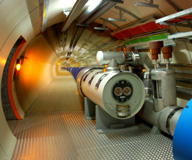

So as you said seven - so each beam of protons has about three and a half trillion electron volts. GORDON: And actually, we were able to take that data across the Atlantic on the fibers and analyze them here in the U.S.įLATOW: What does that mean, seven teravolts?ĭr. It was spectacular to be able to sit here in New York and watch on the Web all of our colleagues in Switzerland, as you say, colliding those protons together and seeing the first collision.ĭr. ATLAS Operations): Thank you, Ira, nice to talk to you.ĭr. HOWARD GORDON (Deputy Operations Program Manager U.S. ATLAS Operations at CERN, and he's also a senior scientist at Brookhaven National Lab out there in Long Island in Upton. He is the deputy operations program manager for U.S.

The particles met at a record breaking seven trillion electrical volts.Īnd joining me now to talk about what all these numbers mean and how much research we can expect to see coming out of it now that it's up and running is Howard Gordon. And they set - they've already set a world record. The LHC - it's up and running again, and on Tuesday physicists flip the switch, send the particle beams going in different directions, right at each other. After being shut down for months of repairs, the Large Hadron Collider - now, that's that giant super-collider that's colliding particles together on the border of France and Switzerland. The second season of data taking produced five times more data than Run 1.Up next, a smashing success at the world's largest physics experiment. The LHC’s second run (Run 2) began in 2015 and lasted till 2018. The Higgs boson and its related energy field are believed to have played a vital role in the creation of the universe. This led to Peter Higgs and his collaborator François Englert being awarded the Nobel Prize for physics in 2013. The discovery concluded the decades-long quest for the ‘force-carrying’ subatomic particle, and proved the existence of the Higgs mechanism, a theory put forth in the mid-sixties. Ten years ago, on July 4, 2012, scientists at CERN had announced to the world the discovery of the Higgs boson or the ‘God Particle’ during the LHC’s first run. Newsletter | Click to get the day’s best explainers in your inbox (ATLAS is the largest general purpose particle detector experiment at the LHC the Compact Muon Solenoid (CMS) experiment is one of the largest international scientific collaborations in history, with the same goals as ATLAS, but which uses a different magnet-system design.) Given these requirements, it is not easy to warm up or cool down the gigantic machine. The LHC uses a distribution system of liquid helium to keep its critical components ultracold at minus 271.3 degrees Celsius, which is colder than interstellar space. Since the LHC’s powerful electromagnets carry almost as much current as a bolt of lightning, they must be kept chilled. The particles are so tiny that the task of making them collide is akin to firing two needles 10 km apart with such precision that they meet halfway,” according to the European Organisation for Nuclear Research (originally Conseil Européen pour la Recherche Nucléaire, or CERN, in French), which runs the particle accelerator complex that houses the LHC. “Just prior to collision, another type of magnet is used to ‘squeeze’ the particles closer together to increase the chances of collisions. The magnetic field created by the superconducting electromagnets keeps the protons in a tight beam and guides them along the way as they travel through beam pipes and finally collide.


 0 kommentar(er)
0 kommentar(er)
